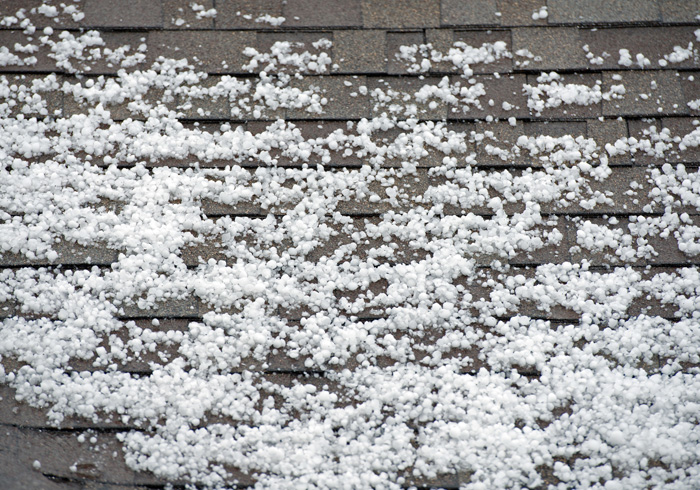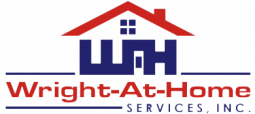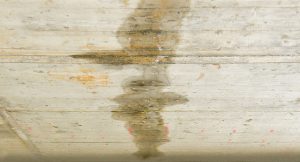
A hail damaged roof can eventually lead to a leaky roof. It may seem like something out of a Saturday morning cartoon, but having a bucket on the floor to catch leaking water from a roof is not an uncommon problem. There are many different factors that can cause your roof to leak, which results in problems such as mildew, mold, and fungus. These problems can weaken the integrity of your roof and ceiling, which, left unchecked will result in a catastrophic disaster.
Causes of a Leaking Roof
Extreme weather, hail damage, strong winds, and animals seeking shelter from the elements can all cause some extensive problems for your roof. Thunderstorms can produce strong winds, tornadoes, and hail that can severely damage shingles, rip them off your roof, and scatter them across your yard.
Animals also take advantage of damaged roofs, finding holes in which they can sneak in and burrow in attics or crawl spaces left behind by torn shingles. This helps them stay out of the elements but causes a huge problem for the rest of your home. Animals can bring about diseases, parasites, and leave dirt throughout your home. This can cause family members to get sick. Animals can also cause leaks in your roof, as they burrow more, tearing up shingles and making holes, allowing water to seep in whenever it rains.
Moss and Lichen build up is also a problem, as moisture becomes trapped under the shingles, these plants begin to grow like weeds. This problem can be easily spotted if you notice that your roof is turning green in color. Moss and lichen not only cause problems in your roof by rotting away the shingles, but it can also lead to major health concerns, especially if you, or anyone in your family, has allergies.
Hail damaged roofs are common in the Twin Cities area. But, the severe weather isn’t the only cause of a leaking roof. Many homes, that have an attic A/C unit do not initially think of the unit is a source of a problem. Since A/C helps us escape the unbearably hot summers, it seems odd to think that it could cause water to build up in your roof. A/C Units have coils that run through your house, allowing the cool air to move to the different vents. Because of the extreme change in temperature from inside the coils and on the outside, condensation builds up over time. A/C units have a built-in water pan, to help catch this condensation, and the pan empties out into some pipes which allows it to escape your house. When dirt and other debris from either the coils or from other factors inside your home, the pipes can get blocked up, causing the water to build up in the pan. When this happens, water begins to leak and pull up. Left for too long, or unnoticed, the water can cause a decrease in the integrity of your ceiling. Over time, the ceiling will begin to disintegrate which could lead to either a cave in or a chunk to fall out. Not only is this dangerous and a headache to fix, but it can also be costly, and on top of that, you would still need to pay to have the A/C Unit fixed, to avoid having the problem for a second time.
Prevention Measures to Protect the Roof
There are some tricks that can help you make sure that you protect your roof. Treatments, such as roof cleaners, will help make sure that your roof does not have any buildup of mildew or moss, and makes it harder for these types of fungus to grow. Trimming trees back, to make sure the branches do not reach the roof, will not only help prevent moisture to remain trapped in the shingles but will also make it safer during heavy storms, so branches don’t crash or scratch against your roof.
It is also a good habit to check the shingles on your roof every so often, as damaged shingles could lead to weakening patches in your roof. If you notice a patch of damage shingles, it might be time to get some replacements or even consider getting a new roof.
Finally, making sure that your A/C Unit is working properly, and that the pipes, allowing the pan to get rid of water, isn’t blocked will give you the peace of mind that there is no hidden leak within your ceiling.
How Do I Know If My Hail Damaged Roof is Leaking?
A leaking roof is a serious problem and it is important to know the signs that your roof may need some repairs.
Rain water leaking into the roof, causing water damage.
- Stains along the ceiling in any part of your home are usually tell-tale signs that there is a leak.
- Water dripping from the ceiling and pooling up on your floor is also the sign that your roof is struggling to either dispel of the water or that there is moisture build up in your ceiling. When you notice the water is dripping and have to get a bucket to make sure that it is not ruining your carpet or hardwood floor, it is definitely time to get some help.
- Walls swelling or even spots in the ceiling swelling, are also signs that there is a leak within your home. This often times accompanied by moisture building up along the outside of the wall, as water tries to find some way to escape.
- Missing shingles or debris building up in your downspouts, along with any of these other signs are strong indicators that you have a leaking roof on your hands. It is extremely vital at this point to make sure that you call a professional to help you take care of the problem before it gets any worse.
Not sure who to call? Wright at Home Services in Maple Grove, MN will be able to help you with any of your roofing needs, whether it be an emergency or just a routine check. Call us at 763-493-2724.
Is A Leaking / Hail Damaged Roof Covered By Insurance?
We understand it can be intimidating to try and figure out how much of a financial strain it is going to be on your family to repair a hail damaged or leaking roof. At Wright at Home Services, we take the time to work with your insurance company to make sure that you are getting the help you need without putting your family in financial turmoil.
We work with most insurance providers, and before we even get in contact with them, come and do an inspection on your home. This way, not only do we help ease your frame of mind, but we also help the insurance companies understand exactly how extensive are the damages and how much it looks like they are going to have to pay. If you are still unsure of exactly what it is you are supposed to saying or filing to your insurance company, don’t fret, we can help you through the whole process.
Other Common Questions about Leaking Roofs
Is a leaking roof an emergency?
Not initially, but if a leaking roof is ignored for too long, or goes unnoticed, it could turn into one. Damages to your home from water and the threat of the ceiling falling in become higher the longer the problem persists. It should be taken care of soon as it is noticed, as waiting just makes it worse.
Can a leaking roof cause mold?
Yes. Mold is caused by excess moisture which is often the result of a leaking roof. If you see mold in your home, you know that there is a problem and it needs to be addressed. Mold can cause a variety of health problems, such as throat irritation and stuffiness.
How is water damage restoration done?
Water damage restoration has to be done by a trained professional, as they have tools that enable them to soak up the moisture from the ceiling and walls. They will also be able to help salvage any materials that may have been slightly damaged from the leak, and replace those that cannot be salvaged, restoring the integrity to your home. If there is also a mildew smell that developed because of the water damage than they will be able to rid your home of that as well.
Tips on How to Repair Home Water Damage
Just as was mentioned in the question before, if it is damage to the walls or ceiling, then you need to call a professional to do the water damage restoration for you. Other things though, such as clothing and blankets that may have fallen victims to the leak can easily be thrown in the wash (as long as they haven’t been in the water for over 48 hours.) Furniture and other household items, if they have water damage should either be replaced (if mold has started to grow on them) or thoroughly cleaned if no mold has started to grow and they were only in the path of the water for a short bit. Patches of carpet or hardwood flooring should also be inspected for damages or signs of mold, which will appear as discoloration in the flooring.
Damage to hardwood floor thanks to water damage.
Home Water Damage Inspection
A water damage inspection should be done by a trained professional, as they have classes and categories into which they assess the water damage.
- Class 1: Damage is only done to a small part of the room that has collected a little bit of moisture.
- Class 2: The entire room has been destroyed by water damage, and the floors and the walls are still soaked with water.
- Class 3: Water has come from the ceiling and has caused most of the home to be soaked with water and moisture
- Class 4: The water has saturated the hardwood floor, concrete, and or stone of the house. This requires a special drying tool to get rid of the excess water.
- Category 1: The water can come from clean water sources such as toilet tanks or leaking pipes.
- Category 2: Water has come from washing machines or dishwashers. Water from these sources is considered grey water due to the chemicals used in the machines.
- Category 3: Water coming from sewage or standing water which has been able to grow mold and mildew. This type of water can cause illnesses and parasites to grow within the home.
If you notice a hail damaged roof or any of these problems and need an honest opinion, call us today at 763-493-2724. We are here for you and all of your roofing needs.






